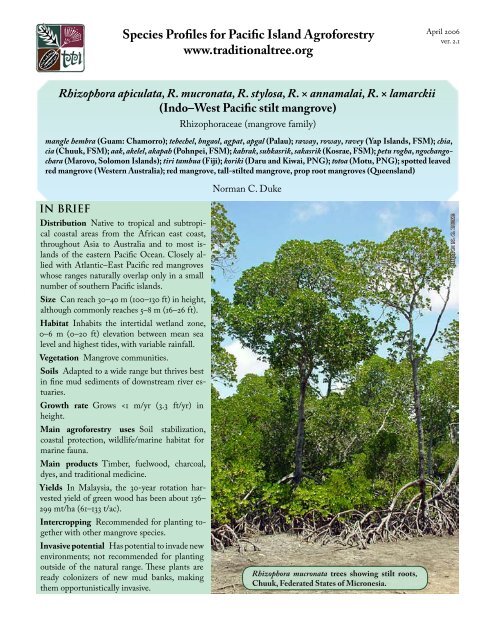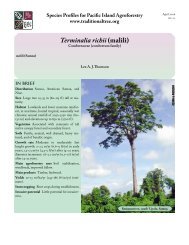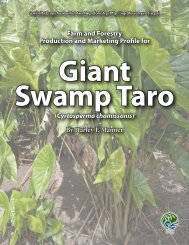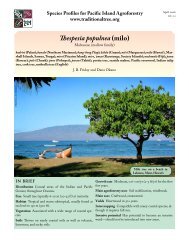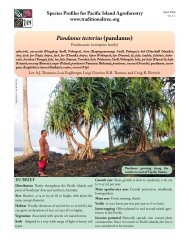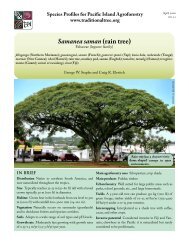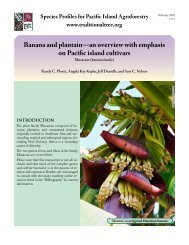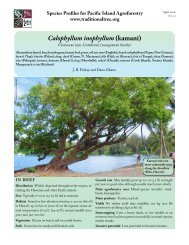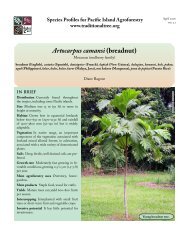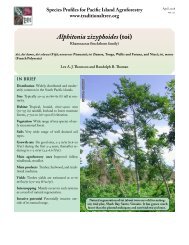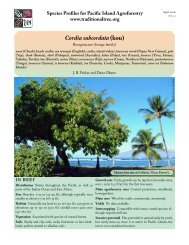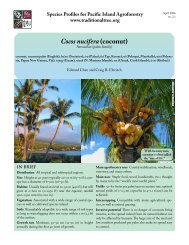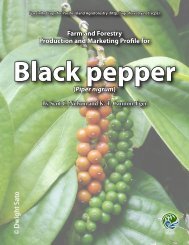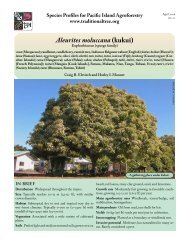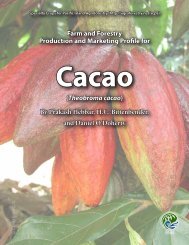Rhizophora apiculata, R. mucronata, R. stylosa, R ... - Agroforestry Net
Rhizophora apiculata, R. mucronata, R. stylosa, R ... - Agroforestry Net
Rhizophora apiculata, R. mucronata, R. stylosa, R ... - Agroforestry Net
Create successful ePaper yourself
Turn your PDF publications into a flip-book with our unique Google optimized e-Paper software.
<strong>Rhizophora</strong> <strong>apiculata</strong>, R. <strong>mucronata</strong>, R. <strong>stylosa</strong>, R. × annamalai, R. × lamarckii<br />
(Indo–West Pacific stilt mangrove)<br />
<strong>Rhizophora</strong>ceae (mangrove family)<br />
mangle hembra (Guam: Chamorro); tebechel, bngaol, agpat, apgal (Palau); raway, roway, ravey (Yap Islands, FSM); chia,<br />
cia (Chuuk, FSM); aak, akelel, akapah (Pohnpei, FSM); kahrak, suhkasrik, sakasrik (Kosrae, FSM); petu rogha, ngochangochara<br />
(Marovo, Solomon Islands); tiri tambua (Fiji); koriki (Daru and Kiwai, PNG); totoa (Motu, PNG); spotted leaved<br />
red mangrove (Western Australia); red mangrove, tall-stilted mangrove, prop root mangroves (Queensland)<br />
IN BRIEF<br />
Species Profiles for Pacific Island <strong>Agroforestry</strong><br />
www.traditionaltree.org<br />
Distribution Native to tropical and subtropical<br />
coastal areas from the African east coast,<br />
throughout Asia to Australia and to most islands<br />
of the eastern Pacific Ocean. Closely allied<br />
with Atlantic–East Pacific red mangroves<br />
whose ranges naturally overlap only in a small<br />
number of southern Pacific islands.<br />
Size Can reach 30–40 m (100–130 ft) in height,<br />
although commonly reaches 5–8 m (16–26 ft).<br />
Habitat Inhabits the intertidal wetland zone,<br />
0–6 m (0–20 ft) elevation between mean sea<br />
level and highest tides, with variable rainfall.<br />
Vegetation Mangrove communities.<br />
Soils Adapted to a wide range but thrives best<br />
in fine mud sediments of downstream river estuaries.<br />
Growth rate Grows
INTRODUCTION<br />
Indo–West Pacific stilt mangroves (IWP <strong>Rhizophora</strong> species)<br />
are widespread throughout most tropical coastal areas<br />
of the western Pacific region to east Africa. This group is<br />
one of two that make up the genus <strong>Rhizophora</strong> and consists<br />
of three species (two being closely allied), R. <strong>mucronata</strong>, R.<br />
<strong>stylosa</strong>, and R. <strong>apiculata</strong>, and two hybrids, R. × lamarckii<br />
and R. × annamalai.<br />
Stilt mangroves thrive under a range of intertidal conditions,<br />
including a range of salinity levels from near freshwater<br />
to full strength seawater. They tolerate a range of<br />
flooding regimes, soil types, and other physical site factors.<br />
Typically, these mangroves are common in the mid-intertidal<br />
zone, and particularly along the seaward margin of<br />
tropical mangrove stands.<br />
<strong>Rhizophora</strong> are considered the most important of all mangrove<br />
genera across the Pacific tropical region. However,<br />
the benefits provided by stilt mangroves are difficult to<br />
separate from the larger role of mangroves and mangrove<br />
ecosystems in general. Mangroves are known to play a vital<br />
role in shoreline protection, enhancement of water quality<br />
in nearshore environments (including coral reefs), and in<br />
supporting estuarine and marine food chains. In most parts<br />
of the Pacific, trees are harvested for firewood, so the trunk<br />
is the main part of the tree considered for direct use.<br />
DISTRIBUTION<br />
Native range<br />
Indo–West Pacific stilt mangroves occur widely throughout<br />
the western Pacific. Specifically, they occur in tropical<br />
and subtropical, intertidal wetlands from the east coast of<br />
Africa, through Asia to Micronesia extending east in the<br />
northwestern Pacific through the Federated States of Micronesia<br />
to the Marshall Islands, and south to northern<br />
Australia extending east in the southern Pacific as far as<br />
Samoa. Distributions appear continuous, but separate species<br />
have different preferred locations where they dominate:<br />
•<br />
•<br />
•<br />
•<br />
R. <strong>mucronata</strong> occurs mostly in areas subject to regular<br />
freshwater flows (at least in the eastern part of its<br />
range)<br />
R. <strong>stylosa</strong> occurs in marine situations often preferring<br />
more exposed offshore sites<br />
R. <strong>apiculata</strong> is often found mid–lower estuary in larger<br />
riverine estuaries and embayments<br />
the hybrid R. × lamarckii is found downstream in middle<br />
to higher intertidal locations.<br />
Indo–West Pacific <strong>Rhizophora</strong> species<br />
<strong>Rhizophora</strong> <strong>mucronata</strong> and R. <strong>stylosa</strong> are sibling species (i.e.,<br />
possibly R. <strong>stylosa</strong> =R. <strong>mucronata</strong> var. <strong>stylosa</strong> (Griff.) Salvoza),<br />
and together they characterize most stands of IWP<br />
stilt mangroves. The range of R. <strong>mucronata</strong> is the widest of<br />
all IWP species, extending from east Africa, where it occurs<br />
as the sole <strong>Rhizophora</strong>, to the western Pacific, where it<br />
overlaps with all other IWP species. In contrast, R. <strong>stylosa</strong><br />
extends exclusively east, notably into the southwestern Pacific.<br />
The range of R. <strong>apiculata</strong> also extends further east in<br />
the south Pacific than R. <strong>mucronata</strong>, but otherwise its range<br />
mostly fits within the ranges of other IWP <strong>Rhizophora</strong>. The<br />
status of observed differences in similar forms, R. <strong>mucronata</strong><br />
and R. <strong>stylosa</strong>, will only be resolved in genetic studies<br />
and selected breeding programs.<br />
The two hybrid taxa presumably have distributions in keeping<br />
with their hybrid status. As such, they are located wherever<br />
the ranges of their putative parents overlap. Confirmed<br />
records of hybrid distributions show R. × lamarckii to be<br />
widespread in the western Pacific, while R. × annamalai<br />
was found in India and Sri Lanka along the western limits<br />
of R. <strong>apiculata</strong>. However, considerable confusion is expected<br />
in the field distribution records, because these hybrids<br />
WHAT IS A MANGROVE?<br />
Mangroves form a unique and dominant ecosystem<br />
comprised of intertidal marine plants, mostly trees,<br />
predominantly bordering margins of tropical coastlines<br />
around the world. These halophytic (salt tolerant)<br />
plants thrive in saline conditions and daily inundation<br />
between mean sea level and highest astronomical<br />
tides, and they provide vital structure as habitat<br />
and food for similarly adapted resident and transient<br />
fauna. Mangrove plants exchange gases from exposed<br />
roots using special lenticels, while flooding tides allow<br />
uptake of river-borne nutrients and frequent dispersal<br />
by their buoyant propagules. The ecological limits defined<br />
by the diurnal tidal range explain the setting and<br />
why just 70 species around the world are considered<br />
to be mangroves (Tomlinson 1986, Duke et al. 1998),<br />
compared with adjacent rainforests that may have<br />
hundreds of tree species per hectare. Specialized morphological<br />
and physiological characteristics largely<br />
define and characterize mangrove plants, such as buttress<br />
trunks and roots providing support in soft sediments,<br />
aboveground roots allowing vital gas exchange<br />
in anaerobic sediments, and physiological adaptations<br />
for excluding or expelling salt. Fewer than 22 plant<br />
families have developed such essential attributes, representing<br />
independent instances of co-evolution over<br />
millions of years to form today’s mangrove habitats.
World distributions of stilt mangroves, the IWP <strong>Rhizophora</strong> species. Given the hybrid status of <strong>Rhizophora</strong> × lamarckii (= R.<br />
<strong>stylosa</strong> × R. <strong>apiculata</strong>) and R. × annamalai (= R. <strong>mucronata</strong> × R. <strong>apiculata</strong>), their distribution is likely where the distributions of<br />
their respective parent trees overlap. Coastlines marked in red indicate the distribution of all mangroves. image: N.C. Duke<br />
are difficult to distinguish based on morphological characters<br />
alone.<br />
Of great interest also in the southwestern Pacific islands<br />
is the only occurrence of another hybrid taxon, R. × selala<br />
(Salvoza) Tomlinson, derived from putative parents R.<br />
samoensis (=R. mangle?) and R. <strong>stylosa</strong> (=R. <strong>mucronata</strong> var.<br />
<strong>stylosa</strong>?). This hybrid taxon is special because R. samoensis<br />
is a key member of the AEP red mangrove <strong>Rhizophora</strong><br />
species. The occurrence of this hybrid means there appears<br />
to be very little genetic separation between these defining<br />
and most divergent of <strong>Rhizophora</strong> species.<br />
Current distribution<br />
There are no reports of any stilt mangroves occurring outside<br />
their natural range. However, these species are recognized<br />
as valuable timber producers, so it is possible that<br />
their dispersal east in the Pacific and elsewhere may have<br />
been assisted by indigenous peoples in the past.<br />
BOTANICAL DESCRIPTION<br />
Preferred scientific names<br />
<strong>Rhizophora</strong> <strong>mucronata</strong> Lamk.<br />
<strong>Rhizophora</strong> <strong>stylosa</strong> Griff. (= R. <strong>mucronata</strong> var. <strong>stylosa</strong> (Griff.)<br />
Salvoza)<br />
<strong>Rhizophora</strong> <strong>apiculata</strong> Bl.<br />
<strong>Rhizophora</strong> × lamarckii Montr. (= R. <strong>stylosa</strong> × R. <strong>apiculata</strong>)<br />
<strong>Rhizophora</strong> × annamalai K. Kathiresan. (= R. <strong>mucronata</strong> × R.<br />
<strong>apiculata</strong>)<br />
Family<br />
<strong>Rhizophora</strong>ceae (mangrove family)<br />
Common names<br />
aak, akelel, akapah (Pohnpei, FSM)<br />
abat (Ceram, Indonesia)<br />
ailave, kailau (Aru, Indonesia)<br />
bakau (Malay Peninsula, Singapore, Borneo, Sumatra)<br />
bakauan, bakau, bakhaw (Philippines)<br />
bako ( Java, Indonesia)<br />
bangka (Acheh, Indonesia)<br />
chia, cia (Chuuk, FSM)<br />
Indo–West Pacific stilt mangroves (English)<br />
kahrak, suhkasrik, sakasrik (Kosrae, FSM)<br />
koriki (Daru and Kiwai, PNG)<br />
lolaro, belukap (Sulawesi, Indonesia)<br />
mangle hembra (Guam: Chamorro)<br />
ngochangochara, petu rogha (Marovo, Solomon Islands)<br />
prop root mangroves (northeastern Australia)<br />
Species Profiles for Pacific Island <strong>Agroforestry</strong> (www.traditionaltree.org)
away, roway, ravey (Yap Islands, FSM)<br />
red, tall-stilted mangrove (Queensland)<br />
spotted leaved red mangrove (Western Australia)<br />
tebechel, bngaol, agpat, apgal (Palau)<br />
tiri tambua (Fiji)<br />
totoa (Motu, PNG)<br />
Size<br />
Indo–West Pacific stilt mangroves are medium to tall trees<br />
that may reach 30–40 m (100–130 ft) in height, although<br />
they are commonly much shorter, around 5–8 m (16–26 ft).<br />
Stem diameters are often about 15–35 cm (6–14 in) taken<br />
just above the highest prop root. This measure differs fundamentally<br />
from the standard diameter at breast height<br />
(dbh) used for most forest surveys, as diameter height<br />
above the substrate varies from 0.5 to 7 m (1.6–23 ft) (consider<br />
the tree in the photo on the first page).<br />
Form<br />
Stilt mangroves are rambling to columnar trees with distinct<br />
aboveground prop roots. Trees tend to be of shorter stature<br />
and more spreading in shape on the seaward edge of stands<br />
or in areas of higher salinity. Taller, single-stemmed trees<br />
are found most often just behind the water’s edge of stands<br />
midstream in major riverine estuaries. Multi-stemmed<br />
trees are common in more arid or marginal habitats.<br />
Flowering<br />
Flowers are perfect. Inflorescences have few to many<br />
joints with 1,2-chotomous branching and one to many<br />
buds possible per inflorescence. Open flowers are located<br />
within or below leaf axils at leaf nodes below the apical<br />
shoot, depending on species. For R. <strong>mucronata</strong>, R. <strong>stylosa</strong>,<br />
R. × annamalai. R. × lamarckii, and R. <strong>apiculata</strong> mature<br />
buds and flowers are located at 1–3, 1–5, 3–5, 3–6, and 6–11<br />
nodes down from apical shoot, respectively. Calyces are<br />
typically pale yellow at maturity with 4 lobes, rarely 3. Buds<br />
are obovate, green when immature to pale yellowish green<br />
as they mature, dimensions 1–2 cm (0.4–0.8 in) long and ~1<br />
cm (0.4 in) wide. Petals, usually 4, are lanceolate to linear,<br />
creamy white, woolly to hairless, ~10 mm (0.4 in) long and<br />
~2 mm (0.08 in) wide. Stamens number 7–12, pale yellow.<br />
Style is pale green, terete, 0.5–6 mm (0.02–0.24 in) above<br />
base, dichotomous tip. Bracts and bracteoles are variable<br />
depending on species. Mature bud bracts are slender green<br />
(R. <strong>mucronata</strong>, R. <strong>stylosa</strong>), swollen green (R. × annamalai,<br />
R. × lamarckii) and swollen corky green (R. <strong>apiculata</strong>). Peduncles<br />
are 1–7 cm (0.4–2.8 in) long, and ~3 mm (0.12 in)<br />
wide. Flowering period is chiefly during August–December<br />
in the southern hemisphere, and during February–June<br />
in the northern hemisphere.<br />
Indo–West Pacific <strong>Rhizophora</strong> species<br />
Leaves<br />
Leaves are opposite, simple, light or dark green, obovate,<br />
leathery, margins revolute, bluntly acute apex with a distinct<br />
mucronate tip, 1–7 mm (0.04–0.3 in) long. Upper leaf<br />
surface is smooth, shiny. Cork wart spots occur on undersurface,<br />
scattered evenly, not raised, present in most species<br />
in most locations, but absent only from R. <strong>apiculata</strong> and<br />
R. × lamarckii in southern New Guinea and Australia. Mature<br />
leaf dimensions are 6–19 cm (2.4–7.5 in) long, and 3–10<br />
cm (1.2–3.9 in) wide. Petiole 1–4 mm (0.04–0.16 in) long.<br />
Leaf emergence is mostly around November–February in<br />
the southern hemisphere and May–August in the northern<br />
hemisphere. Leaf fall occurs mostly during the wet summer<br />
period from October to February in the southern hemisphere<br />
and April–August in the northern hemisphere.<br />
Fruit<br />
Fruits, when mature, are pear-shaped, elongate, waist<br />
constriction, smooth brown surface, calyx lobes elongate<br />
spreading (when hypocotyl ready to emerge). For R. <strong>mucronata</strong>,<br />
R. <strong>stylosa</strong>, R. × annamalai, R. × lamarckii, and R.<br />
<strong>apiculata</strong> mature fruit located in leaf axils 3–5, 4–7, 5 (rare),<br />
7 (rare), and 8 nodes down from apical shoot, respectively.<br />
Seeds/hypocotyls<br />
Like all <strong>Rhizophora</strong> species, stilt mangroves are viviparous,<br />
meaning that the trees produce seeds hidden in the mature<br />
fruit, and these germinate on the parent tree. The dispersal<br />
unit, a viviparous seedling, is called a hypocotyl. One<br />
hypocotyl is usually produced from each fruit, although on<br />
rare occasions twins may be observed.<br />
Hypocotyls are narrowly cylindrical, elongate, green,<br />
smooth with irregular small brown lenticels, distal half is<br />
slightly wider, distal tip is pointed in most taxa, but rounded<br />
to blunt for R. <strong>apiculata</strong>. For R. <strong>mucronata</strong>, R. <strong>stylosa</strong>,<br />
R. × annamalai, R. × lamarckii, and R. <strong>apiculata</strong> mature<br />
hypocotyls are located in leaf axils 4–10, 4–9, none, 8–9<br />
(rarely observed), and 9–13 nodes down from the apical<br />
shoot, respectively. Hypocotyl dimensions are variable and<br />
not consistently species-specific, 14–80 cm (6–31 in) long,<br />
1–2 cm (0.4-0.8 in) at the widest point, and 0.5–1.5 cm<br />
(0.2–0.6 in) wide at the “collar,” the fruiting structure that<br />
envelops the plumule (embryonic leaves).<br />
“Fruiting,” when mature hypocotyls fall, occurs chiefly (but<br />
not exclusively) from November to January in the southern<br />
hemisphere and May to July in the northern hemisphere.<br />
Bark<br />
The bark is gray to dark gray and heavily fissured, occa-
Top left: The distinct mucronate (abrupt, pointed) tip at the apex of leaves is characteristic of all IWP stilt <strong>Rhizophora</strong>. The<br />
coloration of the mucronate tip shown in this image of R. <strong>stylosa</strong> is variably red or green. Northeastern Australia. Top right:<br />
Inflorescence of <strong>Rhizophora</strong> <strong>mucronata</strong> (similar to R. <strong>stylosa</strong>) showing open flowers with distinctive woolly petals and slender<br />
smooth bract beneath the calyx. Bottom left: Inflorescence of <strong>Rhizophora</strong> <strong>apiculata</strong> showing open flowers with distinctive hairless<br />
petals, non-reflexed calyx lobes, and corky bract beneath the calyx. Bottom right: Leafy rosette of <strong>Rhizophora</strong> <strong>mucronata</strong><br />
(similar to R. <strong>stylosa</strong>) showing mature buds and mature fruit. photos: N.C. Duke<br />
sionally red-brown and smooth. Prop roots are sturdy even<br />
when relatively thin.<br />
Rooting habit<br />
Mature trees have distinctive, sturdy, aboveground prop<br />
roots surrounding the stem base that anchor only shallowly<br />
in the sediments to 1–2 m (3.3–6.6 ft) depth. This<br />
conforms to the oxygen deficient (anoxic) conditions commonly<br />
measured in mangrove sediments.<br />
Similar species<br />
Stilt mangroves are distinguished from Atlantic–East Pacific<br />
red mangrove species principally by the spiked, mu-<br />
cronate tip at the leaf apex of stilt mangroves that is absent<br />
in red mangroves.<br />
<strong>Rhizophora</strong> <strong>mucronata</strong> and R. <strong>stylosa</strong> have slender (i.e., length<br />
much greater than the width) bracts at the base of mature<br />
buds as distinguished from R. <strong>apiculata</strong>, R. × lamarckii, and<br />
R. × annamalai that have bracts almost as wide, or wider<br />
than the length.<br />
<strong>Rhizophora</strong> <strong>apiculata</strong> is distinguished from R. × lamarckii<br />
and R. × annamalai plus other IWP species by swollen<br />
(wider than long), corky brown bracts, one inflorescence<br />
joint, and node position of mature buds and flowers in leaf<br />
axils at 6–11 nodes down from apical shoot, well below<br />
leaves in the leafy shoot.<br />
Hybrid characteristics are shown in R. × lamarckii where<br />
Species Profiles for Pacific Island <strong>Agroforestry</strong> (www.traditionaltree.org)
Mature hypocotyls of <strong>Rhizophora</strong> <strong>stylosa</strong> (similar to R. <strong>mucronata</strong>).<br />
Great Sandy Straits, NE Australia. photo: N.C. Duke<br />
Left to right: Mature flower buds of <strong>Rhizophora</strong> <strong>apiculata</strong>,<br />
R. × lamarckii, R. <strong>stylosa</strong>, and R. <strong>mucronata</strong>. These samples<br />
were collected in NE Australia, where the four species grow<br />
side by side in several estuaries. photo: N.C. Duke<br />
Indo–West Pacific <strong>Rhizophora</strong> species<br />
it has key characters intermediate between R. <strong>apiculata</strong><br />
and R. <strong>stylosa</strong>. Similarly, hybrid characteristics are shown<br />
in R. × annamalai, which has key characters intermediate<br />
between R. <strong>apiculata</strong> and R. <strong>mucronata</strong>. Hybrids can often<br />
be larger and taller than neighboring parent trees.<br />
<strong>Rhizophora</strong> × lamarckii is distinguished from R. × annamalai<br />
by style length
elated to differences in habitat. It is clear that<br />
R. <strong>stylosa</strong> is the taxon best adapted to marine<br />
exposed locations wherever it occurs.<br />
It is of great interest to fully evaluate the relative<br />
and precise distributions of R. <strong>mucronata</strong><br />
and R. <strong>stylosa</strong>, because these are likely to explain<br />
the way species have naturally evolved and dispersed.<br />
In some island groups to the north of<br />
Australia, for instance, there is a curious pattern<br />
in separate sympatric occurrences where these<br />
species are easily distinguished in some populations<br />
(Philippines, Sulawesi) while in others<br />
(Federated States of Micronesia, Palau) their<br />
style lengths overlap, making it impossible to<br />
always tell them apart using this character. This<br />
may be explained by a progressive lengthening<br />
of the style in R. <strong>stylosa</strong>, corresponding possibly<br />
with its more recent introduction in locations<br />
with longer styles. If this is correct, R. <strong>stylosa</strong><br />
has spread from Australia and Federated States<br />
of Micronesia both westward and eastward;<br />
for example, in Sulawesi and Fiji where style<br />
lengths are the longest recorded. This idea concurs<br />
with the specialized marine habit of this<br />
species.<br />
By contrast, R. <strong>apiculata</strong> is readily distinguished<br />
from R. <strong>mucronata</strong> and R. <strong>stylosa</strong>. This species<br />
appears more prevalent in estuaries influenced<br />
by larger and more continuous freshwater flows,<br />
and it is found in a continuous distributional<br />
range, from India to the western Pacific and northern<br />
Australia. Across this range there are also two forms of R.<br />
<strong>apiculata</strong>, and their occurrences do not overlap. One form,<br />
found north and west from the northern New Guinea<br />
coast, fits the type description in every respect including<br />
the presence of cork wart spots on leaf undersurfaces. The<br />
other form lacking these spots occurs south and east from<br />
the southern New Guinea coast. This character was thought<br />
to be unique to R. <strong>apiculata</strong> until recently, when trees of R.<br />
racemosa (an AEP red mangrove) without spots were discovered<br />
in Brazil. This character helps define two forms of<br />
R. <strong>apiculata</strong> in Australasia and the western Pacific.<br />
Known varieties and hybrids<br />
<strong>Rhizophora</strong> <strong>mucronata</strong> and R. <strong>stylosa</strong> are both known to<br />
hybridize with R. <strong>apiculata</strong>, giving rise to morphologically<br />
distinct and geographically widespread hybrid forms,<br />
R. × annamalai and R. × lamarckii, respectively. Their hybrid<br />
status was initially based on intermediate morphological<br />
characters but has since been confirmed in genetic<br />
investigations.<br />
Variation in style length of <strong>Rhizophora</strong> <strong>stylosa</strong> and R. <strong>mucronata</strong> in the IWP<br />
region. Note that for each species, but especially for R. <strong>stylosa</strong>, larger styles<br />
occur in eastern and western populations. images: N. C. Duke<br />
As discussed above, R. <strong>mucronata</strong> and R. <strong>stylosa</strong> are sibling<br />
species with few diagnostic characters to separate them<br />
and a corresponding lack of genetic separation. This clearly<br />
makes it difficult to separate respective hybrid forms with<br />
R. <strong>apiculata</strong>, although this may be done by also using the<br />
style length character. The situation is more complex, however,<br />
when it must be considered further that there are the<br />
two forms of R. <strong>apiculata</strong>. These each have hybrids with<br />
R. <strong>stylosa</strong> based on occurrences north and south of New<br />
Guinea.<br />
IWP stilt mangroves are also characterized by a number of<br />
notable genetic, morphological, and growth variants. Aberrant<br />
traits are observed in a small number of individuals<br />
throughout the range. Perhaps the most consistent aberrant<br />
trait, however, is “albino” hypocotyls (i.e., those lacking<br />
any green pigment, leaving them red or yellow) observed in<br />
Australia, Federated States of Micronesia, Palau, and other<br />
places. Yellow or red propagules can be observed hanging<br />
in affected trees alongside normal green propagules of all<br />
IWP species. Their relative number on an individual tree is<br />
thought to quantify the amount of outcrossing that occurs<br />
with neighboring normal trees. On rare occasions, other<br />
Species Profiles for Pacific Island <strong>Agroforestry</strong> (www.traditionaltree.org)
trees have also been observed with variegated<br />
foliage.<br />
Culturally important related species<br />
All <strong>Rhizophora</strong> species are closely similar in tree<br />
form, and different cultural groups in the Pacific<br />
region may not always distinguish between<br />
them. Other mangrove genera, like Bruguiera,<br />
are considered close in form and value also, and<br />
these are often used in similar ways by indigenous<br />
peoples.<br />
ASSOCIATED PLANT SPECIES<br />
IWP stilt mangroves are naturally associated<br />
with a number of other mangrove and nonmangrove<br />
species across their wide range of<br />
tidal and estuarine locations. Planting with<br />
other species is highly recommended, particularly<br />
terrestrial and beach strand associates<br />
growing naturally above mean sea level elevations.<br />
The idea is to establish and achieve wholeof-bank<br />
stabilization as soon as possible. Since<br />
stilt mangroves also occupy a range of substrate<br />
types, including coral, rocks, gravel, sand, and mud, it is<br />
important to choose associated species best suited to the<br />
particular local conditions.<br />
Associated species commonly found<br />
The associated species vary with geographic location, latitude,<br />
soil type, estuarine upstream location, and tidal position.<br />
In frontal stands, IWP stilt mangroves may be associated<br />
with Sonneratia alba and Avicennia marina downstream.<br />
Where downstream stands of stilt mangroves are backed<br />
by sand ridges and beach margins, the associated species<br />
include Calophyllum spp., Thespesia spp., Casuarina spp.,<br />
Barringtonia asiatica, and Cocos nucifera.<br />
Upstream in riverine estuaries of tropical coastlines of<br />
larger islands and continental margins, associated species<br />
include Sonneratia caseolaris, S. lanceolata, and Aegiceras corniculatum.<br />
In such upstream locations, stilt mangroves are<br />
commonly backed by Bruguiera and other higher intertidal<br />
mangrove species, as well as associated upland species including<br />
Barringtonia racemosa and Hibiscus tiliaceus.<br />
Indo–West Pacific <strong>Rhizophora</strong> species<br />
Foliage of <strong>Rhizophora</strong> <strong>mucronata</strong> showing a tree with a rare yellow “albino”<br />
form of hypocotyls among the normal green hypocotyls. Johnstone River,<br />
NE Australia. photo: N. C. Duke<br />
ENVIRONMENTAL PREFERENCES<br />
AND TOLERANCES<br />
Climate<br />
IWP stilt mangroves thrive in tropical and subtropical<br />
environments characterized by moderately high and well<br />
distributed rainfall. However, in drier locations, like in<br />
northern areas of Western Australia, the stunted but dense<br />
thickets of R. <strong>stylosa</strong> attest to the great adaptability of stilt<br />
mangroves to a wide range of climatic types.<br />
Elevation range<br />
0–6 m (0–20 ft), in reference to mean sea level.<br />
Mean annual rainfall<br />
These mangroves grow in all rainfall conditions. Their extent,<br />
form, and biomass reflect the different rainfall conditions.<br />
Rainfall pattern<br />
Grows in climates with summer or uniform rainfall patterns.<br />
Dry season duration (consecutive months with < 0<br />
mm [1. in] rainfall)<br />
Mangrove plants appear to depend on groundwater to sustain<br />
optimal growth, especially during drier months. Across<br />
a wide variety of climatic regions, mangrove cover expands
and contracts through time. This has been evident in correlations<br />
between El Niño events and reduced growth as<br />
possible causes of some damage to mangroves, presumably<br />
due to decreases in freshwater availability.<br />
Mean annual temperature<br />
20–30°C (68–86°F) (estimate)<br />
Mean maximum temperature of hottest month<br />
23–38°C (73–100°F) (estimate)<br />
Mean minimum temperature of coldest month<br />
13–18°C (55–64°F)<br />
Minimum temperature tolerated<br />
10°C (50°F) (estimate)<br />
Soils<br />
Trees develop greatest stature and columnar growth form<br />
in estuaries of larger tropical rivers, characterized by fine<br />
clay, black mud sediments with relatively high loads of organic<br />
carbon, and anaerobic soils with high concentrations<br />
of sulfide. Trees also grow well in sites with aerobic sediments<br />
consisting of fine sands to coarse stones and rocks,<br />
as well as coral ramparts.<br />
Soil texture<br />
Plants grow best in light, medium, and heavy texture soils<br />
(sands, sandy loams, loams, sandy clay loams, sandy clays,<br />
clay loams, and clays).<br />
Soil drainage<br />
Plants grow best in soils with free and un-impeded drainage,<br />
as well as waterlogged soils.<br />
Soil acidity<br />
pH 6–8.5<br />
Special soil tolerances<br />
Plants grow best in saline soils but can survive well in fresh<br />
water. The optimal salinity range is reported to be 8–26 ppt<br />
(parts per thousand), compared to approximately 34–36 ppt<br />
for seawater.<br />
Tolerances<br />
Drought<br />
Stilt mangroves usually grow best in wetter conditions.<br />
However, R. <strong>stylosa</strong> and western range R. <strong>mucronata</strong> can<br />
tolerate drought periods well.<br />
Full sun<br />
They usually grow best in full sun.<br />
Shade<br />
MANGROVES AND CLIMATE<br />
CHANGE<br />
Indo–West Pacific stilt mangroves, like other mangrove<br />
species, are affected by climate change. The unique<br />
physiological characteristics of each species define its<br />
capacity for survival in the face of change. Mangroves<br />
are expected to respond rapidly and decisively to shifts<br />
in key factors, like temperature, rainfall, and sea level,<br />
as each species has defined ranges of tolerance for each<br />
factor. For instance, because mangroves are characteristically<br />
restricted to elevations between mean sea level<br />
and highest tides, as sea level rises their communities<br />
must move upland to survive. Since mangroves have<br />
narrow optimal temperature ranges, rising temperatures<br />
will cause their distributions to shift north or<br />
south to areas where temperature conditions are most<br />
suitable, and they will die off in areas where they are<br />
not suited. Of course, their success in making these<br />
shifts depends on their successful dispersal and re-establishment,<br />
and the availability of suitable new space.<br />
Clearly, such changes have occurred throughout history,<br />
so the distribution of mangroves today represents<br />
the survivors of all past changes.<br />
Key indicators of change can be identified and mapped<br />
as incremental shifts and responses of mangrove communities.<br />
These might be observed as shifts in vegetation,<br />
for example: 1) in the total tidal wetland habitat<br />
zone, as expected with changes in sea level; and 2) in<br />
the salt marsh–mangrove ecotone, as expected with<br />
changes in longer-term rainfall patterns as this affects<br />
moisture stress in saline environments. In both cases,<br />
the response zones will follow elevation contours.<br />
Changes along contours can be quantified from longterm<br />
spatial assessments over decade- and centurylong<br />
time periods, depending on the rates of change.<br />
Knowledge of these changes and their causes allows<br />
better prediction of future change.<br />
Stilt mangroves are usually considered to have a very low<br />
tolerance of shade. However, in eastern Australia at its<br />
southern latitudinal limit, R. <strong>stylosa</strong> trees commonly grow<br />
under a closed canopy of Avicennia marina. This may be<br />
Species Profiles for Pacific Island <strong>Agroforestry</strong> (www.traditionaltree.org)
due to the absence of scolytid beetle larvae that<br />
usually infect shaded propagule-seedlings in<br />
the tropics (Brook 2001). If this is the case, it<br />
implies <strong>Rhizophora</strong> seedlings might be more<br />
shade tolerant than originally thought (Sousa<br />
et al. 2003). This is supported further by the<br />
observation that Bruguiera species, the apparent<br />
shade specialists of tropical areas, had few<br />
scolytid infections.<br />
Fire<br />
The trees have no tolerance of fire in close proximity.<br />
Frost<br />
They have low tolerance of sub-freezing temperatures.<br />
Waterlogging<br />
Stilt mangrove trees are tolerant of daily tidal<br />
flooding up to depths of 2.5 m (8 ft). While<br />
tolerating permanently saturated soils, they are<br />
intolerant of drying soils.<br />
Salt spray<br />
They are highly tolerant of salt spray.<br />
Wind<br />
Some species of stilt mangrove trees are typically<br />
found on the exposed water’s edge of large<br />
riverine estuaries.<br />
Abilities<br />
Self-prune<br />
Stilt mangroves self-prune well in dense stands, but they<br />
commonly maintain lower branches in more open locations.<br />
Coppice<br />
The trees have notably poor coppice ability. Generally, if<br />
greater than 50% or more of the leaves are removed from<br />
a tree, they will die. There appears to be a variant of R.<br />
<strong>apiculata</strong> in the Philippines and in some islands of the<br />
Federated States of Micronesia (Pohnpei and Kosrae) that<br />
is used by local people for sustainable firewood collection.<br />
These trees regrow from regular cutting, which keeps them<br />
stunted.<br />
GROWTH AND DEVELOPMENT<br />
Growth rates vary with age. The tree generally grows less<br />
10 Indo–West Pacific <strong>Rhizophora</strong> species<br />
Trunk of <strong>Rhizophora</strong> <strong>mucronata</strong> showing distinctive stilt roots. Kenya, E<br />
Africa. photo: N. C. Duke<br />
than 1 m/yr in height but can exceed this in favorable circumstances.<br />
Height growth is rapid shortly after establishment<br />
while food reserves are taken up from the hypocotyls<br />
of established propagules. The growth rates appear to slow<br />
when trees approach a site maximal canopy height, dependant<br />
on specific site/location conditions. When near maturity,<br />
trees tend to spread and broaden their canopy and<br />
stem diameter rather than grow taller.<br />
Flowering and fruiting<br />
Flowering and fruiting periods of stilt mangroves are distinctly<br />
seasonal. Furthermore, peak pheno-events shift<br />
later with cooler temperatures and higher latitudes. Trees<br />
have notable and relatively long periods of reproductive<br />
development, taking 18–30 months from first emergence<br />
of flower bud primordia until maturation and drop of mature<br />
hypocotyls. The duration depends on species, with the
longest being <strong>Rhizophora</strong> <strong>apiculata</strong>, with around 30 months<br />
for each reproductive cycle.<br />
Yields/growth rates<br />
Growth rates vary with species, spatial position in the<br />
stand, competition, vigor, and age. In the Matang Mangrove<br />
Forest Reserve in Malaysia, Putz and Chan (1986)<br />
reported that diameter growth rates of R. <strong>apiculata</strong> trees<br />
were 0.24–0.29 cm (0.09–0.11 in) for diameter size classes<br />
from 10 to 60 cm (4–24 in).<br />
Watson (1928) estimated that under Malaysian conditions<br />
mean annual increment (MAI) of stilt mangroves culminated<br />
at around 10.6 m 3 /ha/yr (152 ft 3 /ac/yr) at 39–40 years.<br />
Reaction to competition<br />
Rapid early growth of seedlings of stilt mangroves in full<br />
sunlight ensures their success and dominance in preferred<br />
estuarine and intertidal conditions. Newly established<br />
seedlings grow best in close proximity with their same<br />
species cohort. This affords them maximal protection from<br />
physical damage by drift logs and erosive waves. Since<br />
competition is high between neighboring seedlings, slower<br />
plants die and decompose quickly, leaving faster competitors<br />
the benefit of not only the space they occupied but<br />
also their nutrients.<br />
PROPAGATION<br />
IWP stilt mangroves are readily propagated by direct<br />
planting of their propagules. Although natural<br />
regeneration is generally relied upon around the<br />
Pacific region, these species are relatively easy to<br />
propagate. Propagation is simple and relies on<br />
the special feature of the genus in having large<br />
viviparous propagules. Planting simply entails<br />
gently pushing the distal end of the 20–80 cm<br />
(8–31 in) long hypocotyl one third of its length<br />
into the sediment, spaced at about 1–1.5 m (3.3–5<br />
ft) intervals. No holes need be dug, and neither<br />
nursery preparation nor stakes are needed. Low<br />
maintenance is generally required for maximizing<br />
seedling establishment success in sheltered<br />
areas. However, substantial protection is required<br />
in more exposed coastal locations during<br />
the first decade of establishment. Such protection<br />
methods may include encasement of indi-<br />
vidual seedlings in PVC piping (Riley and Kent<br />
1999), or installation of temporary structures to<br />
dampen wave action and reduce debris drift<br />
across restoration sites as observed in Vietnam and China<br />
(Field 1996).<br />
Propagule collection<br />
Propagules may be available throughout the year, but peak<br />
production occurs around July–August in northern parts<br />
of the range and around January–February in the southern<br />
hemisphere. Mature propagules may be collected after they<br />
have fallen or been picked directly off trees. Only healthy<br />
looking propagules should be selected. Propagules that<br />
are shrunken or desiccated in appearance or that exhibit<br />
significant physical damage should be rejected. Although<br />
propagules with only minor borer damage may survive and<br />
grow, selection of propagules with no signs of borer or crab<br />
damage is strongly preferred. Propagules that already have<br />
some root or leaf development can be used in most cases<br />
but should not be stored for long.<br />
Propagule processing<br />
Processing of mature propagules is not required for stilt<br />
mangroves, although damaged and insect infested individuals<br />
should be removed. Also see the following pretreatment<br />
section for possible additional steps. Propagules can<br />
be sown in nursery beds, or preferably planted directly in<br />
the field soon after collection.<br />
Propagule storage<br />
Propagules can be kept viable for at least 6–7 days by storing<br />
them in brackish water or by wrapping them in wet<br />
Left: Mature hypocotyl and fruits of <strong>Rhizophora</strong> <strong>mucronata</strong> showing distinctive<br />
collar on attached propagule and expended fruit. photo: N. C. Duke<br />
Right: A sectioned wilting seedling of <strong>Rhizophora</strong> <strong>stylosa</strong> shows the extent<br />
of scolytid infection marked by brown frass. photos: B. m. Brook<br />
Species Profiles for Pacific Island <strong>Agroforestry</strong> (www.traditionaltree.org) 11
urlap bags and keeping them out of direct<br />
sunlight. Pretreatment is considered essential if<br />
considering such storage (see below). It is likely<br />
that propagules can be kept longer, but storage<br />
beyond 2 weeks is not recommended, and longterm<br />
storage is not feasible.<br />
Propagule pretreatment<br />
Pretreatment of propagules is generally considered<br />
unnecessary. However, a study of scolytid<br />
beetle larvae (Coccotrypes fallax) infections<br />
on <strong>Rhizophora</strong> propagules in Australia found<br />
at least 18% that were heavily infested (Brook<br />
2001). Infested propagules were established under<br />
canopy-shaded areas. The study went further,<br />
finding that pretreatment in a 50°C (122°F)<br />
water bath for 5 minutes killed the beetles and<br />
removed the risk of establishment loses due to<br />
borer damage. Heat treatment might be easily<br />
achieved by leaving the collected propagules in<br />
the sun for a short period (a few hours) before<br />
planting.<br />
Growing area<br />
Stilt mangroves should be grown in full sunlight.<br />
Seedling establishment<br />
Leaves and roots may begin to develop within a week or<br />
two of sowing.<br />
Media<br />
Although a wide variety of soil media are acceptable, a mix<br />
of sand and peat in equal parts has been recommended for<br />
mangrove nurseries.<br />
Time to outplanting<br />
Anytime during the year is suitable. Seedlings are ready<br />
for outplanting at the 6-leaf (=3 node) stage if grown up<br />
in nursery conditions. Older seedlings up to 0.5 m (20 in)<br />
tall have also been successfully transplanted, but this is not<br />
considered beneficial.<br />
Direct planting of large numbers of propagules is restricted<br />
by their peak seasonal availability, as propagules do not<br />
keep for extended periods unless planted out in nursery<br />
conditions.<br />
Guidelines for outplanting<br />
Propagules or nursery-grown seedlings usually have excellent<br />
survival in sites correctly selected and, if appropriate,<br />
1 Indo–West Pacific <strong>Rhizophora</strong> species<br />
New planting on seaward edge of R. <strong>apiculata</strong> at Ao Khung Krabaen Mangrove<br />
Forestry Center, Som Lek, Thailand. photo: C. elevitCh<br />
protected from disturbance. Survival rates of 90% or greater<br />
are not unreasonable in such circumstances.<br />
On the other hand, survival may be zero on sites exposed<br />
to excessive wave action, on sites with inappropriate hydrologic<br />
or salinity regimes, or (rarely) disturbance by grazing<br />
animals (e.g., goats, sheep, cattle, and horses). A method of<br />
encasing propagules in PVC pipe has been used in Florida<br />
and the Caribbean to protect seedlings in places with a<br />
high likelihood of disturbance.<br />
DISADVANTAGES<br />
In general, the planting of stilt mangroves poses few significant<br />
disadvantages when planted within their native ranges.<br />
They are not especially susceptible to pests or pathogens<br />
and they have not been reported to host major pests or<br />
pathogens of important crop species.<br />
Potential for invasiveness<br />
Although the invasiveness of stilt mangroves has not been<br />
demonstrated, they are likely to be opportunistic due to<br />
their relatively wide tolerance for salinity and soil conditions.<br />
The spread of the closely allied AEP red mangrove<br />
species R. mangle when introduced into Hawai‘i has clearly<br />
demonstrated the potential for invasiveness of these mangroves.<br />
Although they were not native, suitable growing<br />
conditions existed, demonstrating that the global distribution<br />
of <strong>Rhizophora</strong> spp. is currently limited by their natural
Benefits include, in no particular order (adapted from<br />
Tomlinson 1986):<br />
• visual amenity and shoreline beautification<br />
• nutrient uptake, fixation, trapping, and turnover<br />
• habitat use by fauna<br />
dispersal range. This also means geographically isolated<br />
populations are vulnerable to introductions of genotypes<br />
from elsewhere.<br />
Susceptibility to pests/pathogens<br />
Susceptibility to pests and diseases is believed to be low,<br />
with the exception of insect borers and crabs that feed on<br />
propagules.<br />
Host to crop pests/pathogens<br />
No reports were found of stilt mangroves serving<br />
as hosts for known major crop pests or<br />
pathogens. The scolytid beetles are specific to<br />
the genus <strong>Rhizophora</strong>.<br />
AGROFORESTRY/<br />
ENVIRONMENTAL<br />
PRACTICES<br />
Mulch/organic matter<br />
Mulch in <strong>Rhizophora</strong> forests is hidden from view.<br />
If it were not for the small mangrove crabs, fallen<br />
leaves would be washed away with each tide.<br />
The crabs actively take leaves into underground<br />
burrows and chambers. The resulting mulch is<br />
rapidly colonized by bacteria and consumed by<br />
BENEFITS OF MANGROVE TIDAL WETLAND<br />
• mesoclimate, where forests moderate evapotranspiration<br />
to create a specialized niche climate<br />
• nursery habitat for young fauna, where mangroves<br />
provide a source of food and physical protection from<br />
predation<br />
• sanctuary niche for mature fauna, including migratory<br />
birds and fish, where mangroves provide protection<br />
and a food resource<br />
• primary production based on photosynthesis, giving<br />
rise to forest growth and forest products, notably timber<br />
• secondary production, including microbial and faunal<br />
production, as well as grazers, and via decomposition<br />
• fishery products, including both estuarine and coastal<br />
• shoreline protection, based on general mangrove tree<br />
and root structure, as well as edge trees, which reduce<br />
erosion and provide stand protection from waves and<br />
water movement<br />
• carbon sequestration and a sink where carbon is bound<br />
within living plant biomass<br />
• sediment trapping, based on mangroves being a depositional<br />
site for both water and airborne sediments,<br />
which in turn reduces turbidity of coastal waters.<br />
other burrowing fauna to release nutrients that appear to<br />
further enhance the forest.<br />
Soil stabilization<br />
Stilt mangrove forests stabilize soils with their network<br />
of sturdy overlapping prop roots dampening water movement<br />
and promoting sedimentation in areas that might<br />
otherwise be eroded.<br />
<strong>Rhizophora</strong> <strong>mucronata</strong> tree growing on the edge of an estuarine channel.<br />
While the stem leans out over the water to get the most light, the stilts<br />
both support the tree and stabilize the bank. photo: N. C. Duke<br />
Species Profiles for Pacific Island <strong>Agroforestry</strong> (www.traditionaltree.org) 1
Fence posts<br />
Stilt mangrove stems make good posts since they are generally<br />
hard wood and resistant to insect borers.<br />
Windbreaks<br />
<strong>Rhizophora</strong> forests provide a windbreak along coastal margins,<br />
generally, and as places to seek sanctuary during typhoons<br />
and cyclones. Planting in highly wind-prone locations<br />
is not recommended unless the location has some<br />
history, or reasonable expectation, that mangrove survival<br />
is likely.<br />
Woodlot<br />
Mangroves adjacent to peoples’ homes throughout the Pacific<br />
frequently serve as informal woodlots, particularly on<br />
islands with clear tenure systems that include mangrove<br />
areas. Stilt mangrove wood is very useful for small construction,<br />
and for cooking fuel. Converting it to charcoal<br />
can further enhance the timbers’ calorific value. This is<br />
done commercially in SE Asia and Central America with<br />
various <strong>Rhizophora</strong> species.<br />
Native animal/bird food<br />
IWP stilt mangroves are largely an unknown source of<br />
native animal foods. However, several observations demonstrate<br />
that the diversity and quantity of the source is<br />
thought to be extremely important in mangrove ecosystems.<br />
Numerous insects, crabs, and mollusks graze on<br />
green leaves in the forest canopy. Sesarmid crabs consume<br />
a large quantity of fallen leaves and propagules. Organic<br />
matter processed by these herbivores is believed to broadly<br />
support aquatic food chains in coastal regions. Few mammals<br />
appear to use stilt mangroves as a major food source,<br />
although native rats often chew into the wood in search of<br />
boring insect larvae.<br />
Wildlife habitat<br />
In addition to aquatic marine organisms (see Fish/marine<br />
food chain), stilt mangroves serve as habitat for a wide<br />
range of terrestrial and arboreal wildlife. In various locations<br />
throughout the region, these forests provide shelter<br />
and food for a number of associated fauna, including birds,<br />
fruit bats, small mammals, shellfish, and other marine life.<br />
Bee forage<br />
<strong>Rhizophora</strong> species have no nectar, but they do produce copious<br />
pollen that is usually distributed by wind.<br />
Fish/marine food chain<br />
Mangroves in general are believed to play a vitally important<br />
role in protecting and supporting marine food chains.<br />
Many fish species use stilt mangroves during part of their<br />
1 Indo–West Pacific <strong>Rhizophora</strong> species<br />
<strong>Rhizophora</strong> <strong>stylosa</strong> sprouted propagules for sale in Iriomote,<br />
Japan. photo: N. C. Duke<br />
life cycles, as do species of shrimp and crabs. Species such<br />
as the mangrove mud crab (Scylla serrata) are common in<br />
IWP mangroves, and these are important sources of food<br />
and income on many islands in the region. Populations<br />
of some smaller species may exceed 10 crabs/m 2 (1 crab/<br />
ft 2 ) in parts of the Pacific. Senescent leaves having fallen<br />
from <strong>Rhizophora</strong> trees are taken by grapsid (small mangrove)<br />
crabs into their burrows. Buried leaves decompose<br />
and contribute to nutrient recycling in mangrove forests.<br />
Nutrients also feed directly and indirectly to associated estuarine<br />
and marine food chains.<br />
Coastal protection<br />
Stilt mangrove forests, and mangroves in general, play an<br />
important role in protection of coastlines, fishponds, and<br />
other coastal infrastructure. Stilt mangroves are planted<br />
for coastal or fishpond protection in some areas (e.g., in<br />
Kalibo Bakhawan Eco Park, the Philippines) and there are<br />
laws in many locations aimed at protecting mangroves in<br />
large part because of this important function.<br />
Ornamental<br />
No significant ornamental trade is known. However, as an
apparently isolated example, a small number of plants are<br />
sold as souvenirs to departing tourists from Iriomote and<br />
other southern islands of Japan. Sprouted hypocotyl seedlings<br />
are used to make bonsai “forest gardens.”<br />
USES AND PRODUCTS<br />
IWP stilt mangroves are probably of greatest value for their<br />
environmental benefits, because they (and mangroves generally)<br />
are believed to play a vital role in supporting<br />
marine food chains, protecting coastal<br />
areas, and improving water quality.<br />
In terms of direct benefits to people, the most<br />
widespread use of stilt mangroves is for wood<br />
for a range of purposes from cooking fuel to<br />
construction of homes and canoe parts. Other<br />
uses of the stilt mangroves include tannin and<br />
dyes. A less lauded benefit has been derived<br />
from some ecotourism ventures. The dual benefit<br />
in this practice comes from both a moderate<br />
economic return combined with a substantial<br />
longer-term educational value in raising environmental<br />
awareness in the community.<br />
Staple food<br />
Leaves and hypocotyls are edible but not widely<br />
used for food.<br />
Medicinal<br />
Stilt mangrove bark has reportedly been used<br />
to treat angina, boils, and fungal infections. The<br />
leaves and bark have been used as an antiseptic<br />
and to treat diarrhea, dysentery, fever, malaria,<br />
and leprosy, although it is not clear how effective<br />
the treatments have been in each of these<br />
cases.<br />
Timber<br />
The wood of stilt mangroves is widely used<br />
for structural components (e.g., poles, beams,<br />
flooring, wall-cladding, and rafters) of traditional<br />
homes and other structures like underground<br />
mine supports, fencing, cabinet works,<br />
tool handles, and boat anchors. The wood is also<br />
used for other purposes, ranging from traditional<br />
uses such as fishing stakes, spears, and copra-huskers<br />
to use as a source of chips for pulp<br />
production. However, pulp from <strong>Rhizophora</strong><br />
species does not have good strength properties,<br />
so these species are not often sought after for<br />
this purpose (Percival and Womersley 1975).<br />
Fuelwood<br />
Stilt mangrove wood is used for fuelwood on many Pacific<br />
islands (e.g., Kosrae and Chuuk). The wood is also made<br />
into charcoal in countries such as the Philippines, Indonesia,<br />
and Malaysia (Ong et al. 1980, 1995).<br />
Canoe/boat/raft making<br />
The wood has been used to make canoe parts.<br />
Top: Mangrove tourism in Hainan, China, complete with <strong>Rhizophora</strong><br />
motifs on the jetty handrail panels. photo: N. C. Duke Bottom: Boardwalk<br />
and signage for visitors (R. <strong>mucronata</strong> on left and R. <strong>apiculata</strong> on right), Ao<br />
Khung Krabaen Mangrove Forestry Center, Som Lek, Thailand. photo: C.<br />
elevitCh<br />
Species Profiles for Pacific Island <strong>Agroforestry</strong> (www.traditionaltree.org) 1
Tannin/dye<br />
The bark and hypocotyls are used to produce dyes ranging<br />
from red-brown to black (the latter with repeated dying).<br />
<strong>Rhizophora</strong> species are the best producers of tannins of all<br />
the mangroves with 20–25% of bark weight (Percival and<br />
Womersley 1975). Chopped bark is treated by continuous<br />
countercurrent extraction with first cold then warm water<br />
producing an extract called “cutch.” The cutch can be<br />
exported for processing and final tannin extraction. Tannins<br />
were used extensively for preserving cotton ropes and<br />
netting. Mangrove tannins can be used to prepare tannin<br />
formaldehyde adhesives. These adhesives are recognized<br />
for their high moisture resistance and waterproof grades in<br />
plywood and particleboard production. <strong>Rhizophora</strong> tannins<br />
are also known to impart a red color to finished leather<br />
tanning, but this is considered undesirable since blending<br />
with other tannin extracts is needed.<br />
Ecotourism<br />
The mangrove environment is attractive and interesting<br />
to both local people and to visiting tourists. In China, for<br />
example, facilities have been provided to assist and regulate<br />
this form of ecotourism, including a dedicated hotel<br />
and restaurants. Simple boardwalks in other places (e.g.,<br />
Australia, Thailand) are relatively low key but the intention<br />
is the same, to provide public access for those wanting<br />
to see and learn about this fascinating environment. The<br />
boardwalks are there to make the mangrove experience as<br />
effortless as possible while protecting the mangroves from<br />
direct damage. Walks are often also accompanied with informative<br />
and educational signage.<br />
COMMERCIAL CULTIVATION<br />
Stilt mangrove timber is harvested commercially for charcoal<br />
production in SE Asia. The calorific value of the timber<br />
is significantly enhanced by converting it to charcoal.<br />
This is done with various <strong>Rhizophora</strong> species. Charcoal<br />
production has been conducted in a sustainable way on<br />
the Malay Peninsula for over 100 years using silvicultural<br />
practices developed for <strong>Rhizophora</strong> species, especially R.<br />
<strong>apiculata</strong> (Ong et al. 1980, 1995). In addition, forests in Malaysia,<br />
New Guinea, and the Solomon Islands have been<br />
clear-felled for wood chips using unsustainable harvesting<br />
practices.<br />
Spacing<br />
Mangrove plantations in general are typically planted at<br />
spacings of about 1.0–1.5 m (3.3–5 ft). Spacing wider than<br />
about 2.5 m (8 ft) tends to result in a high proportion of<br />
multiple-stemmed and/or shorter trees. Wider spacing<br />
1 Indo–West Pacific <strong>Rhizophora</strong> species<br />
Eleven-year-old plantation of <strong>Rhizophora</strong> <strong>apiculata</strong> in the<br />
63 ha (156 ac) Bakhawan Eco Park at Kalibo, northern Panay,<br />
Philippines. photo: N. C. Duke<br />
and the resulting spreading trees may be desired for coastal<br />
protection projects, but not for timber production. In the<br />
absence of significant natural mortality timber plantations<br />
should be thinned to spacing of 2.5 to 3.5 m (8–11 ft) between<br />
trees as the stand develops and becomes crowded.<br />
Management objectives<br />
In areas where the mangrove fern (Acrostichum speciosum)<br />
is common, it may need to be controlled to promote early<br />
growth of stilt mangroves. Some published guidelines for<br />
mangrove silviculture exist and are referenced below, but<br />
specific guidelines on thinning, fertilizing, etc., are currently<br />
unavailable.<br />
Growing in polycultures<br />
Stilt mangroves naturally occur in mixed-species stands,<br />
and each species has its own ecological and economic values.<br />
Mixed-species plantings are recommended together<br />
with large-leaf mangrove, Bruguiera gymnorrhiza. It is also
important to plant associated buffer areas, especially along<br />
the shoreline where mangroves grow better adjacent to<br />
banks stabilized by shoreline upland plants. Suitable upland<br />
tree genera include Calophyllum, Casuarina, Hibiscus,<br />
Thespesia, and Barringtonia. Within the mangrove forest,<br />
natural recruitment will often bring additional mangroves<br />
such as Bruguiera species, but these might be planted as<br />
well. Together they will complement and enhance the<br />
richness and stability of the planted environment.<br />
Estimated yield<br />
Snedaker and Brown (1982) state that mangrove forest products<br />
in Bangladesh have an annual value of US$36,000,000.<br />
Ong (1982) reports that the Matang Reserve in Malaysia<br />
with 35,000 ha (86,000 ac) of productive, almost monospecific,<br />
forests of R. <strong>apiculata</strong>, the value of mangrove wood<br />
alone is close to US$9,000,000 per year.<br />
The Matang Mangrove Forest Reserve in Malaysia has<br />
been managed for timber production of chiefly <strong>Rhizophora</strong><br />
<strong>apiculata</strong> since the beginning of the century and is reputedly<br />
the best managed mangrove forest in the world (Khoon<br />
and Ong 1995, Ong et al. 1995). The average stand volume<br />
for these stilt mangroves was 153 m 3 /ha (2190 ft 3 /ac). Stand<br />
volumes up to 226 m 3 /ha (3230 ft 3 /ac) have been reported<br />
from Thailand.<br />
The present management plan for the Matang Reserve<br />
is a 30-year rotation period with two thinnings, at 15 and<br />
20 years. The 30-year rotation harvested yields have been<br />
around 136–299 mt/ha (61–133 t/ac) of green wood. However,<br />
there has been a decline in yield from 299 mt/ha (133<br />
t/ac) from virgin stands to the second-generation yields of<br />
158 mt/ha (70 t/ac) in 1967–69 to an even lower 136 mt/ha<br />
(61 t/ac) in 1970–77. Because the standing biomass of the<br />
trees did not increase from 23 years (155 mt/ha [69 t/ac])<br />
to 28 years (153 mt/ha [68 t/ac]), it was suggested that a<br />
rotation of 25 years be used instead of the previous recommendation<br />
of 30 years.<br />
Markets<br />
Markets on most Pacific islands are local in nature, with<br />
little in the way of stilt mangrove products (other than indirect<br />
products like mangrove crabs and fruit bats) being<br />
exported from one island to another. The exception is probably<br />
firewood and charcoal, which is available from local<br />
markets in most places. In Southeast Asia, large quantities<br />
of stilt mangrove wood chips and charcoal may be moved<br />
greater distances and in greater volumes than wood products<br />
on smaller islands.<br />
INTERPLANTING/FARM<br />
APPLICATIONS<br />
Some interplanting systems include:<br />
Example 1—Bakhawan Eco Park (Primavera et al.<br />
2004)<br />
Location<br />
Aklan, New Buswang, and Kalibo, Philippines<br />
Description<br />
Planting was undertaken in 1989 and 1993. Species planted<br />
included R. <strong>apiculata</strong> and R. <strong>mucronata</strong> on a total area<br />
planted of 63 ha (156 ac). Sponsors and implementers were<br />
DENR, PACAP AusAID, USWAG, and KASAMA.<br />
Crop/tree interactions<br />
Not known.<br />
Spacing/density of species<br />
Spacing was about 1.5 m (5 ft) for both species.<br />
Example 2 (Primavera et al. 2004)<br />
Location<br />
Guimaras and Nueva Valencia, Philippines<br />
Description<br />
The planting was undertaken in 1994. Species planted included<br />
R. <strong>apiculata</strong> and R. <strong>mucronata</strong> on a total area of<br />
149 ha (368 ac). Funding source and implementers were<br />
DENR-CEP.<br />
Crop/tree interactions<br />
Not known.<br />
Spacing/density of species<br />
Spacing was around 1.5 m (5 ft) for both species.<br />
Example 3 (Primavera et al. 2004)<br />
Location<br />
Iloilo and Carles, Philippines<br />
Description<br />
The planting was done in 2001. Species planted included<br />
R. <strong>apiculata</strong> and R. <strong>mucronata</strong> on a total area of 530 ha<br />
(1300 ac). Funding source and implementers were DENR<br />
Forestry Sector Program: MACABATA-ARM Federated<br />
People’s Organisation.<br />
Species Profiles for Pacific Island <strong>Agroforestry</strong> (www.traditionaltree.org) 1
Crop/tree interactions<br />
Not known.<br />
Spacing/density of species<br />
Spacing was around 1.5 m (5 ft) for both species.<br />
PUBLIC ASSISTANCE<br />
Centre for Marine Studies, Marine Botany Group<br />
The University of Queensland<br />
St. Lucia QLD 4072<br />
Australia<br />
Web: .<br />
BIBLIOGRAPHY<br />
(☛ indicates recommended reading)<br />
Bandaranayake, W.M. 1995. Survey of mangrove plants<br />
from Northern Australia for phytochemical constituents<br />
and UV-absorbing compounds. Current Topics in Phytochemistry<br />
14: 69–78.<br />
Bandaranayake, W.M. 1998. Traditional and medicinal uses<br />
of mangroves. Mangroves and Salt Marshes 2: 133–148.<br />
Bandaranayake, W.M. 1999. Economic, traditional and medicinal<br />
uses of mangroves. AIMS Report 28. Australian<br />
Institute of Marine Science, Townsville, Australia.<br />
Boonnitee, W. 1979. The <strong>Rhizophora</strong>s of Thailand. Biotrop.<br />
Spec. Publ. 10: 23–31.<br />
Bosire, J.O., J. Kazungu, N. Koedam, and F. Dahdouh-Guebas.<br />
2005. Predation on propagules regulates regeneration<br />
in a high-density reforested mangrove plantation. Marine<br />
Ecology Progress Series 299: 149–155.<br />
Brook, B.M. 2001. The effect of Coccotrypes fallax (Coleoptera;<br />
Scolytidae) on the recruitment of <strong>Rhizophora</strong> <strong>stylosa</strong><br />
(Family <strong>Rhizophora</strong>ceae) in North Queensland mangroves.<br />
PhD Thesis. School of Biological Sciences, James<br />
Cook University, Townsville, Queensland.<br />
Chan, H.T. 1994. Mangrove forest management in Malaysia.<br />
ITTO Tropical Forest Update 4(2): 12.<br />
Clarke, A., and L. Johns. 2002. Mangrove nurseries: Construction,<br />
propagation and planting. Fish Habitat Guidelines<br />
FHG 004. Department of Primary Industries,<br />
Queensland Fisheries Service. .<br />
Clough, B.F., and K. Scott. 1989. Allometric relationship for<br />
estimating above-ground biomass in six mangrove species.<br />
Forest Ecol. & Manag. 27(2): 117–128.<br />
Cuong, H.V.V. 1965. <strong>Rhizophora</strong>ceae. Nat. Mus. Nat. Hist.<br />
4: 131–187.<br />
Dahdouh-Guebas, F., S. Hettiarachchi, D. Lo Seen, O.<br />
Batelaan, S. Sooriyarachchi, L.P. Jayatissa, and N. Koedam.<br />
1 Indo–West Pacific <strong>Rhizophora</strong> species<br />
2005. Transitions in ancient inland freshwater resource<br />
management in Sri Lanka affect biota and human populations<br />
in and around coastal lagoons. Current Biology<br />
15(6): 579–586.<br />
Dahdouh-Guebas, F., L.P. Jayatissa, D.D. Nitto, J.O. Bosire,<br />
D.L. Seen, and N. Koedam. 2005. How effective were<br />
mangroves as a defence against the recent tsunami? Current<br />
Science 15: 443–447.<br />
Dahdouh-Guebas, F., C. Mathenge, J.G. Kairo, and N.<br />
Koedam. 2000. Utilization of mangrove wood products<br />
around Mida Creek (Kenya) amongst subsistence and<br />
commercial users. Economic Botany 54(4): 513–527.<br />
Dahdouh-Guebas, F., M. Verneirt, J.F. Tack, and N. Koedam.<br />
1997. Food preferences of Neosarmatium meinerti de Man<br />
(Decapoda : Sesarminae) and its possible effect on the regeneration<br />
of mangroves. Hydrobiologia 347: 83–89.<br />
Dahdouh-Guebas, F., M. Verneirt, J.F. Tack, D. Van Speybroeck,<br />
and N. Koedam. 1998. Propagule predators in Kenyan<br />
mangroves and their possible effect on regeneration.<br />
Marine and Freshwater Research 49(4): 345–350.<br />
De Lacerda, L.D. 2002. Mangrove Ecosystems: Function<br />
and Management. Springer-Verlag, Berlin, Germany.<br />
Ding, H. 1960. A review of the genus <strong>Rhizophora</strong>—with<br />
special reference to the Pacific species. Blumea 10(2):<br />
625–634.<br />
Duke, J.A. n.d. <strong>Rhizophora</strong> <strong>mucronata</strong> Lam. In: Handbook<br />
of Energy Crops. .<br />
Duke, N.C. 1992. Mangrove floristics and biogeography. In:<br />
Robertson, A.I. and D.M. Alongi (eds.). Tropical Mangrove<br />
Ecosystems. American Geophysical Union, Washington,<br />
DC.<br />
Duke, N.C. 1999. The 1998 survey of <strong>Rhizophora</strong> species in<br />
Micronesia. Report to the USDA Forest Service. Marine<br />
Botany Group, Botany Department, The University of<br />
Queensland, Brisbane, Australia.<br />
Duke, N.C., and J.S. Bunt. 1979. The genus <strong>Rhizophora</strong><br />
(<strong>Rhizophora</strong>ceae) in north-eastern Australia. Australian<br />
Journal of Botany 27: 657–678.<br />
Duke, N.C., and Z.S. Pinzón. 1992. Aging <strong>Rhizophora</strong><br />
seedlings from leaf scar nodes: a technique for studying<br />
recruitment and growth in mangrove forests. Biotropica<br />
24(2a): 173–186.<br />
Duke, N.C., M.C. Ball, and J.C. Ellison. 1998. Factors influencing<br />
biodiversity and distributional gradients in<br />
mangroves. Global Ecology and Biogeography Letters 7:<br />
27–47.<br />
Duke, N.C., J. S. Bunt, and W. T. Williams. 1984. Observations<br />
on the floral and vegetative phenologies of northeastern<br />
Australian mangroves. Australian Journal of Botany<br />
32: 87–99.<br />
Duke, N.C., E.Y.Y. Lo, and M. Sun. 2002. Global distribution<br />
and genetic discontinuities of mangroves—emerging
patterns in the evolution of <strong>Rhizophora</strong>. Trees Structure<br />
and Function 16: 65–79.<br />
Durant, C.C.L. 1941. The growth of mangrove species in<br />
Malaya. Malay. For. 10: 3–15.<br />
Ellison, J.C. 1994. Status of mangroves in the South Pacific.<br />
Asian Wetland News 7: 8.<br />
Ellison, J.C. 1995. Systematics and distributions of Pacific<br />
Island mangroves. In: Maragos, J.E., M.N.A. Peterson,<br />
L.G. Eldredge, J.E. Bardach, and H.F. Takeuchi (eds.),<br />
Marine and Coastal Biodiversity in the Tropical Island<br />
Pacific Region, vol. 1. Pacific Science Association, East-<br />
West Center, Honolulu.<br />
Ellison, J.C. 1999. Present status of Pacific Island mangroves.<br />
Marine/Coastal Biodiversity Vol. II. pp 3–19. In: Eldredge,<br />
L.G., J.E. Maragos, and P.L. Holthus (eds.). The Tropical<br />
Island Pacific Region: Population, Development and<br />
Conservation Priorities. Pacific Science Association, East-<br />
West Center, Honolulu.<br />
Field, C.D. (ed.). 1996. Restoration of mangrove ecosystems.<br />
International Society for Mangrove Ecosystems ISME,<br />
Okinawa, Japan, and the International Tropical Timber<br />
Organisation (ITTO).<br />
Fosberg, F.R. 1975. Phytogeography of Micronesian mangroves.<br />
In: Walsh, G., S. Snedaker, and H. Teas. (eds.). pp.<br />
23–42. Proceedings of the International Symposium on<br />
Biological Management of Mangroves. Institute of Food<br />
and Agricultural Science, Gainesville, Florida.<br />
Gong, W.-K., J.-E. Ong, C.-H. Wong, and G. Dhanarajan.<br />
1980. Productivity of Mangrove Trees and its Significance<br />
in a Managed Mangrove Ecosystem in Malaysia. Mangrove<br />
Environmental Research and Management, University<br />
of Malaya, Kuala Lumpur and UNESCO.<br />
Guppy, H.B. 1906. Observations of a Naturalist in the Pacific<br />
between 1896 and 1899. Vol. II. Plant dispersal. Macmillan<br />
and Co., London.<br />
☛ Hogarth, P.J. 1999. The Biology of Mangroves. Oxford<br />
University Press, New York.<br />
Kairo, J.G., F. Dahdouh-Guebas, J. Bosire, and N. Koedam.<br />
2001. Restoration and management of mangrove systems—A<br />
lesson for and from the East African region.<br />
South African Journal of Botany 67: 383–389.<br />
Kathiresan, K. 1995. <strong>Rhizophora</strong> annamalayana: a new species<br />
of mangroves. Environment and Ecology 13(1): 240–241.<br />
Khoon, G. W., and J.-E. Ong. 1995. The use of demographic<br />
studies in mangrove silviculture. Hydrobiologia 295: 255–<br />
261.<br />
Landon, F.H. 1948. Mangrove volume tables. Malayan For.<br />
11(3): 117–120.<br />
La-Rue, C.D., and T.J. Muzik. 1951. Does the mangrove really<br />
plant its seedlings? Science 114: 661–662.<br />
Lo, E., N.C. Duke, and M. Sun. 2002. Phylogenetic evaluation<br />
of <strong>Rhizophora</strong> taxa for conservation management.<br />
Society for Conservation Biology, United Kingdom.<br />
Marco, H.F. 1935. Systematic anatomy of the woods of the<br />
<strong>Rhizophora</strong>ceae. Trop. Woods 44: 1–20.<br />
McCusker, A. 1984. <strong>Rhizophora</strong>ceae. In: George, A.S. pp.<br />
1–10. Flora of Australia 22. Bureau of Flora and Fauna,<br />
Australian Government, Canberra, Australia.<br />
Morton, J.F. 1965. Can the red mangrove provide food, feed<br />
and fertilizer? Economic Botany 19: 113–123.<br />
Noakes, D.S.P. 1955. Methods of increasing growth and obtaining<br />
natural regeneration of the mangrove type in Malaysia.<br />
Malay. For. 18: 23–30.<br />
Ong, J.E. 1982. Mangroves and aquaculture in Malaysia.<br />
Ambio 11(5): 252–257.<br />
Ong, J.-E., G.W. Khoon, and B.F. Clough. 1995. Structure<br />
and productivity of a 20-year-old stand of <strong>Rhizophora</strong><br />
<strong>apiculata</strong> Bl. mangrove forest. Journal of Biogeography 22:<br />
417–424.<br />
Panapitukkul, N., C.M. Duarte, U. Thampanya, P. Kheowvongsri,<br />
N. Srichai, O. Geertz-Hansen, J. Terrados, and<br />
S. Boromthanarath. 1998. Mangrove colonization: mangrove<br />
progression over Pak Phanang (SE Thailand) mud<br />
flat. Estuarine, Coastal and Shelf Science 47: 51–61.<br />
Percival, M., and J.S. Womersley. 1975. Floristics and Ecology<br />
of the Mangrove Vegetation of Papua and New Guinea.<br />
Department of Forests, Division of Botany, Lae, Papua<br />
New Guinea.<br />
Poh-Tay-Soon and P.B.L. Srivastava. 1983. Crop composition<br />
and density after thinnings and before final felling<br />
in the Matang Mangrove Reserve, Perak, Malaysia. Pertanika<br />
5(1): 95–104.<br />
Primavera, J.H., R.B. Sadaba, M.J.H.L. Lebata, and J.P.<br />
Altamirano. 2004. Handbook of Mangroves in the Philippines—Panay.<br />
SEAFDEC Aquaculture Department,<br />
Iloilo, Panay, Philippines.<br />
Pulle, A. 1911. <strong>Rhizophora</strong>ceae. Nova Guinea. Resultat<br />
de L’expedition scientifique neerlandaise a la Nouvelle<br />
Guinee en 1907 et 1909. H.A. Lorentz. 8, 2e Partie, Botanique:<br />
679.<br />
Putz, F.E., and H.T. Chan. 1986. Tree growth, dynamics<br />
and productivity in a mature mangrove forest in Malaysia.<br />
Forest Ecology and Management 17: 211–230.<br />
Rao, T.A., P.V. Suresh, and A.N. Sherieff. 1986. Multiple viviparity<br />
in a few taxa of mangroves. Current Science 55:<br />
259–261.<br />
Riley, R.W., and C.P. Salgado Kent. 1999. Riley encased<br />
methodology: principles and processes of mangrove habitat<br />
creation and restoration. Mangroves and Salt Marshes<br />
3: 207–213.<br />
☛ Robertson, A.I., and D.M. Alongi (eds.). 1992. Tropical<br />
Mangrove Ecosystems. American Geophysical Union,<br />
Washington, D.C.<br />
☛ Saenger, P. 2002. Mangrove Ecology, Silviculture and<br />
Conservation. Kluwer Academic Publishers, Boston.<br />
Species Profiles for Pacific Island <strong>Agroforestry</strong> (www.traditionaltree.org) 1
Salvoza, F.M. 1936. <strong>Rhizophora</strong>. Univ. Philip. Nat. Appl. Sc.<br />
Bull. 5(3): 179–237.<br />
Smith, A.C. 1981. Family 96. <strong>Rhizophora</strong>caeae. Flora<br />
Vitiensis Nova: A New Flora of Fiji, vol. 2. Pacific Tropical<br />
Botanical Garden, Lāwa‘i, Kaua‘i, Hawai‘i.<br />
☛ Snedaker, S.C., and M.S. Brown. 1982. Primary productivity<br />
of mangroves. In: Mitsui, A. and C.C. Black (eds.).<br />
CRC Handbook of Biosolar Resources. CRC Press Inc.,<br />
Boca Raton, Florida.<br />
Sousa, W.P., S.P. Quek, and B.J. Mitchell. 2003. Regeneration<br />
of <strong>Rhizophora</strong> mangle in a Caribbean mangrove forest:<br />
interacting effects of canopy disturbance and a stemboring<br />
beetle. Oecologia 137: 436–445.<br />
Steenis, C.C.V. 1958. Introduction to <strong>Rhizophora</strong>ceae. Flora<br />
Mal. (1)54: 429–444.<br />
Taylor, F.J. 1986. Mangroves in freshwater. Blumea 31: 271–<br />
272.<br />
Thaman, R.R. 1993. One hundred Pacific island agroforestry<br />
species. In: Clarke, W.C. and R.R. Thaman. <strong>Agroforestry</strong><br />
in the Pacific Islands: Systems for Sustainability. United<br />
Nations University Press, Tokyo. .<br />
☛ Tomlinson, P.B. 1986. The Botany of Mangroves. Cambridge<br />
University Press, Cambridge, UK.<br />
Tomlinson, P.B., R.B. Primack, and J.S. Bunt. 1979. Preliminary<br />
observations on floral biology in mangrove<br />
<strong>Rhizophora</strong>ceae. Biotropica 11(4): 256–277.<br />
Tsuda, S., and M. Ajima. 1999. A preliminary study of resprouting<br />
ability of some mangrove species after cutting.<br />
Tropics 8(3): 221–224.<br />
Walsh, G.E. 1977. Exploitation of mangal. In: Chapman, V.J.<br />
(ed.). Ecosystems of the World: Wet Coastal Ecosystems.<br />
Elsevier Science Publishing Company, Amsterdam.<br />
Walters, B.B. 2005. Patterns of local wood use and cutting<br />
of Philippine mangrove forests. Economic Botany 59(1):<br />
66–76.<br />
Watson, J.G. 1928. Mangrove forests of the Malay peninsula.<br />
Malayan Forest Records 6. Fraser & Neave, Singapore.<br />
Weinstock, J.A. 1994. <strong>Rhizophora</strong> mangrove agroforestry.<br />
Economic Botany 48(2): 210–213.<br />
Wyatt-Smith, J. 1960. Field key to the trees of mangrove forest<br />
in Malaya. Malay. For. 23: 126–132.<br />
0 Indo–West Pacific <strong>Rhizophora</strong> species
Species Profiles for Pacific Island <strong>Agroforestry</strong> (www.traditionaltree.org)<br />
<strong>Rhizophora</strong> <strong>apiculata</strong>, R. <strong>mucronata</strong>, R. <strong>stylosa</strong>, R. × annamalai, R. × lamarckii<br />
(Indo–West Pacific stilt mangroves)<br />
Authors: Norman C. Duke, Marine Botany Group, Centre for Marine Studies, The University of Queensland, St. Lucia QLD 4072,<br />
Australia; .<br />
Acknowledgments: The author and publisher thank Tom Cole, Farid Dahdouh-Guebas, Dale Evans, Ariel Lugo, and Diane Ragone<br />
for their input. Photo contributions by Beth Brook and Craig Elevitch are greatly appreciated. The author acknowledges a host of<br />
people who have over the years supported his journey into <strong>Rhizophora</strong> and who share the passion for this group of plants. Collaborators<br />
and friends include: Jim Allen, Uta Berger, John Bunt, Molly Crawford, Farid Dahdouh-Guebas, Otto Dalhaus, Kathy Ewel,<br />
Candy Feller, XueJun Ge, Gina Holguin, L.P. Jayatissa, Kandasamy Kathiresan, Ken Krauss, Eugenia Lo, Ulf Mehlig, Jaime Polania,<br />
Jurgenne Primavera, Ute Steinicke, Mei Sun, and Nick Wilson.<br />
Recommended citation: Duke, N.C. 2006. <strong>Rhizophora</strong> <strong>apiculata</strong>, R. <strong>mucronata</strong>, R. <strong>stylosa</strong>, R. × annamalai, R. × lamarckii (Indo–West<br />
Pacific stilt mangroves), ver. 2.1. In: Elevitch, C.R. (ed.). Species Profiles for Pacific Island <strong>Agroforestry</strong>. Permanent Agriculture<br />
Resources (PAR), Hōlualoa, Hawai‘i. .<br />
Sponsors: Publication was made possible by generous support of the United States Department of Agriculture Western Region Sustainable<br />
Agriculture Research and Education (USDA-WSARE) Program; SPC/GTZ Pacific-German Regional Forestry Project;<br />
USDA Natural Resources Conservation Service (USDA NRCS); State of Hawai‘i Department of Land & Natural Resources Division<br />
of Forestry & Wildlife; and the USDA Forest Service Forest Lands Enhancement Program. This material is based upon work<br />
supported by the Cooperative State Research, Education, and Extension Service, U.S. Department of Agriculture, and Agricultural<br />
Experiment Station, Utah State University, under Cooperative Agreement 2002-47001-01327.<br />
Series editor: Craig R. Elevitch<br />
Publisher: Permanent Agriculture Resources (PAR), PO Box 428, Hōlualoa, Hawai‘i 96725, USA; Tel: 808-324-4427; Fax: 808-324-<br />
4129; E-mail: par@agroforestry.net; Web: . This institution is an equal opportunity provider.<br />
Reproduction: Copies of this publication can be downloaded from . This publication may be reproduced<br />
for noncommercial educational purposes only, with credit given to the source. © 2006 Permanent Agriculture Resources. All<br />
rights reserved.<br />
Species Profiles for Pacific Island <strong>Agroforestry</strong> (www.traditionaltree.org) 1


